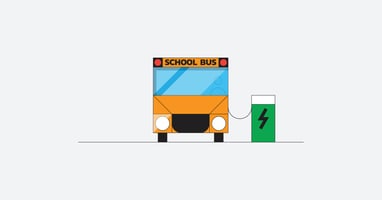Electric School Buses: Maintaining Your Fleet
published on October 01, 2021 by Sonia Mastros
electric school buses, Hybrid Buses, electric school bus, hybrid school buses
 As school districts look to upgrade their aging diesel bus fleets to more modern, ecologically friendly options, electric school buses are becoming an increasingly popular option. Old problems with limited power and battery life are quickly being overcome. Modern electric buses are now an entirely viable option for most districts.
As school districts look to upgrade their aging diesel bus fleets to more modern, ecologically friendly options, electric school buses are becoming an increasingly popular option. Old problems with limited power and battery life are quickly being overcome. Modern electric buses are now an entirely viable option for most districts.
One of the benefits of electric buses is that their maintenance requirements are generally lower than those of diesel buses, but it's still good to know what your district is getting into. Here's a quick overview of the differences in maintenance procedures.
How Electric School Bus Maintenance Varies From Diesel Buses
The biggest difference between the buses, of course, is the use of large electric batteries for power. This leads to the most important thing to know: The battery must be disengaged when doing any sort of under-the-hood or undercarriage maintenance. This should be done about 15 minutes before any work. The wiring is live and carrying current, even when the engine is off, so it's vital to disconnect the battery and let everything discharge. Otherwise, there's a risk of shock.
There's also typically a button on the driver's seat which will perform an emergency battery disconnect - such as in case of fire - but this shouldn't be used for regular maintenance.
The good news is that many aspects of maintenance are reduced:
- There are fewer fluids to manage, generally just lubricants and wiper fluid.
- The engine is much less complicated than an internal combustion engine, generally with only 20-30 parts - compared to hundreds or thousands of parts in a diesel engine. This means far less can go wrong, and repairs are easier if something does go wrong.
- The front dashboard is typically a modified tablet screen, rather than traditional dials, which can be replaced if needed.
- Brake and tire efficiency on electric school buses is significantly better, with typically 4-6x improved performance. This will reduce the maintenance of these systems as well.
So what won't change? Pretty much anything within the interior of the bus. The driver's compartment, seats, windows, etc., are all effectively identical to any other bus. Your cleaning and passenger-related maintenance won't change much.
Electric School Buses Offer Good Value
This all adds up to one of the big reasons that electric buses are gaining in popularity: They may cost more up-front, but your ongoing costs will be reduced significantly going forward. Between cost savings on fuel, reduced maintenance, and longer parts lifespan, electric buses can easily pay for themselves while also improving the environment.
Has your district started buying electric buses lately? What differences did you find most surprising? Let us know in the comments!



